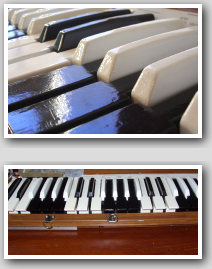
|
|
|
People and resources
relating to the Balanced keyboard
This page lists the people, websites, videos, publications and patents which are
currently known to be associated with
the "Balanced" keyboard layout idea.
"Balanced" keyboard name
Note that there is currently no standardised name for the "Balanced" keyboard
layout, with different people having given it different names - these names are
indicated in quotes in the entries below.
Notes on patenting
Some of the entries below on this page make reference to patenting in relation
to the Balanced keyboard, and also this website occasionally receives enquiries
regarding patenting as well. My understanding of the patenting situation is as
follows (DISCLAIMER: strictly informal notes only):
- The Balanced keyboard layout itself seems to have existed in the public domain for at
least 100 years, possibly much longer. Something can only be patented if
it is original and there has not yet been any information about it in the public domain anywhere in the
world (known as "prior art"). Therefore, the Balanced keyboard layout itself cannot be patented any more
- However, design variations on the layout, any mechanical specifics relating to
it, or a combination of the Balanced keyboard layout in a physical arrangement
together with other controllers or items, probably CAN be patented
"Balanced" keyboard - Bart Willemse (this website)
 This website has been mostly live on the internet since 2003. I came up with the
Balanced keyboard idea independently in 2003, but then gradually became aware
that it had already existed since about 1650.
Various people have kindly been in contact with further historical information,
and also information regarding their own similar projects, as discussed below. This website has been mostly live on the internet since 2003. I came up with the
Balanced keyboard idea independently in 2003, but then gradually became aware
that it had already existed since about 1650.
Various people have kindly been in contact with further historical information,
and also information regarding their own similar projects, as discussed below.
|
"6-6" keyboard - Doug Keislar, Tom Reed, others
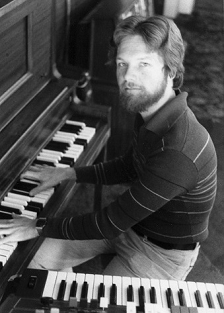 Doug Keislar is the editor of the Computer Music Journal, which is the main
international academic journal for electronic and computer music - see
http://www.mitpressjournals.org/cmj. Doug kindly contacted me in 2010 to say
that he'd built a "6-6" keyboard back in the late 1970's, by converting a
real piano - see photo at right from 1980. Doug Keislar is the editor of the Computer Music Journal, which is the main
international academic journal for electronic and computer music - see
http://www.mitpressjournals.org/cmj. Doug kindly contacted me in 2010 to say
that he'd built a "6-6" keyboard back in the late 1970's, by converting a
real piano - see photo at right from 1980.
Doug explains: "Not being a skilled woodworker, I adopted a simple approach back
in the late 1970s when I constructed my piano keyboard, which was not to change
the octave span. I simply cut off a bunch of keys at the point where they emerge
from within the instrument, replacing them with the opposite kind of key (a
back-row key or a front-row key) where needed. I had to adjust the horizontal
position of some of the pins (I forget the technical term) that guide the key,
but not by much. I used Formica, I think, for the key tops of the black keys in
the front row, and white refrigerator paint to color the white keys in the back
row.... I played it for a while in a nightclub band (along with electric
instruments with traditional keyboards). I've kept it all these years.
".... I originally called my piano a whole-tone keyboard, but later often
referred to it as a 6-6 keyboard, following the terminology coined by Tom Reed;
see
http://orgs.usd.edu/nmm/GiftShop/MNMA/MusicalSixSixNewsletter.html. (I wrote
a long article that constituted the supplement to Issue 26, in 1980.)... The
term 6-6 was originally based on a mistranslation from the Chinese (Mandarin, I
suppose) of a term that to Western ears sounded similar to the word
for "six" in repetition. There are some ancient Chinese stone chimes arranged in
this 6-6 ("balanced") layout, and in fact the pattern also crops up in ancient
Chinese music theory, as can be read about in Musical Six-Six Newsletter -- all
quite fascinating."
|
"Symmetrical" keyboard - Dominique Waller
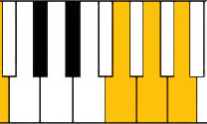 Dominique Waller's
website at http://www.le-nouveau-clavier.fr/english/
gives an excellent historical, conceptual and practical overview of the "Symmetrical" keyboard and
its variants, which is his name for the 6-6 / Balanced keyboard layout. Dominique Waller's
website at http://www.le-nouveau-clavier.fr/english/
gives an excellent historical, conceptual and practical overview of the "Symmetrical" keyboard and
its variants, which is his name for the 6-6 / Balanced keyboard layout.
|
Roger Williams - player of Balanced / 6-6 keyboard
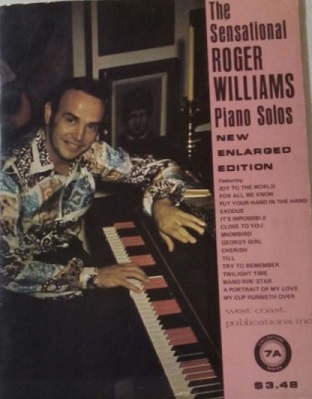 Roger Williams was a distinguished popular music
pianist who passed away in 2011 (see Wikipedia entry here).
Although it is assumed that Roger mainly played the standard keyboard layout, this book
of his piano arrangements features a photo of a Balanced / 6-6 piano keyboard. Roger Williams was a distinguished popular music
pianist who passed away in 2011 (see Wikipedia entry here).
Although it is assumed that Roger mainly played the standard keyboard layout, this book
of his piano arrangements features a photo of a Balanced / 6-6 piano keyboard.
This photo was submitted by
Steve Sanders, who explains: "I am a musician in San Francisco, mostly working
these days as a pit keyboardist / conductor for the Broadway tours that pass through town.
As a child, one of the books I owned was a book of Roger Williams piano arrangements of pop tunes. He was the
pianist that had a big hit with his florid arrangement of “Autumn Leaves" among others.
On the back cover of the book was this photo. There was no mention of it in the book. It was
probably published in the early 1970’s. I’ve always wondered what it was and couldn’t get an answer
from my piano teachers or peers."
Luckily, Doug Keislar (see entry above) recognised it - he explained that the picture
first appeared on the
cover of the now-defunct Modern Keyboard Review, and then subsequently on the cover of the very first
issue of Musical Six-Six Newsletter in 1972. Doug elaborates: “The piano that
Roger Williams had was designed by Hilbert Howe under the name ‘Howe-Way piano’ and manufactured by
Orville Wood. It was one of several such pianos. Williams's piano was a grand. There's a brief
description of the Howe-Way layout and the corresponding notation system
here.
As you can read, C is in the bottom row. Tom Reed [see entry above] has, or had, a Howe-Way upright in
Missouri, and donated a Howe-Way piano to the National Music Museum in South Dakota.”
Although the Howe-Way piano has the same note layout as the Balanced / 6-6 keyboard depicted on this
website, its key colouring approach is a bit different, as can be seen in the photo.
There was an interview with Roger Williams in the Modern Keyboard Review issue, in which he explained his
enthusiasm for the 6-6 keyboard: “It's really wonderful ... if you play a Chopin number, say you play the
Chopin D Flat Prelude, you can also play it in E flat, F, G, A, B, and D flat again. And all you
do is just move up one note on the piano, the fingering's the same, the position on the piano's the
same, any piece you can play in one key, you can automatically play in six other keys.”
|
Jose Perez-Salado Kamps - Spanish patent
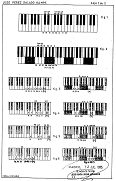 Jose contacted me in
December 2010 to inform of his Spanish patent ES8802099 for aspects of the
"Balanced" keyboard layout. His patent can be viewed on the espacenet European
patent database
HERE.Interestingly,
this patent appears to have been granted in spite of substantial "prior art"
already existing in the public domain (e.g. "Musical Six-Six newsletter" above, and
historical references below), which the Spanish patent office may have missed in
their patentability search? Jose contacted me in
December 2010 to inform of his Spanish patent ES8802099 for aspects of the
"Balanced" keyboard layout. His patent can be viewed on the espacenet European
patent database
HERE.Interestingly,
this patent appears to have been granted in spite of substantial "prior art"
already existing in the public domain (e.g. "Musical Six-Six newsletter" above, and
historical references below), which the Spanish patent office may have missed in
their patentability search?
Jose explains: "I requested a patent for this idea in Spain back in 1985
(including two different variations of the keyboard; see figures 2 and 13 in the patent),
as I was completely unaware of any other prior similar ideas. The patent was awarded some
thirty months later, in 1988. I never came up with a name for the invention and so it was
just called “un instrumento de teclado” (“a keyboard instrument” in Spanish)."
|
Karl Bernhard Schumann - an early "Balanced" keyboard
inventor?
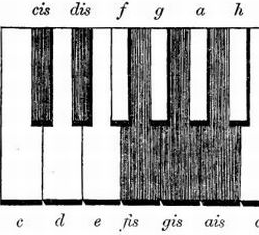 Herbert Hencke's website on keyboard history names Karl Bernhard Schumann as another early
inventor of the Balanced keyboard layout in 1859, mentioned in a book
of 1907 (see the graphic about two-thirds of the way down): Herbert Hencke's website on keyboard history names Karl Bernhard Schumann as another early
inventor of the Balanced keyboard layout in 1859, mentioned in a book
of 1907 (see the graphic about two-thirds of the way down):
- Website in original German
- Website in English (via Google Translate)
|
Alfred Gould and Cyrus Marsh's US patent, 1859
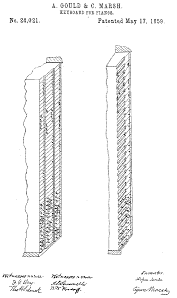 US patent 24,021, entitled "ARRANGEMENT OF KEYBOARD FOR PIANOS, &c" and dated May 17, 1859, names Alfred Gould and Cyrus Marsh
as inventors of the Balanced keyboard-style layout, as well as a related
arrangement of 3 rows of keys. The patent can be found on Google Patents
HERE. US patent 24,021, entitled "ARRANGEMENT OF KEYBOARD FOR PIANOS, &c" and dated May 17, 1859, names Alfred Gould and Cyrus Marsh
as inventors of the Balanced keyboard-style layout, as well as a related
arrangement of 3 rows of keys. The patent can be found on Google Patents
HERE.
|
Grace Frix's US patent, 1995
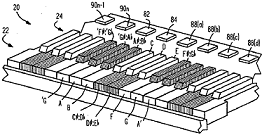 Grace Frix patented some design variations of the Balanced keyboard layout in her 1995 US patent 5,404,788. The
patent can be found on Google Patents
HERE. Grace Frix patented some design variations of the Balanced keyboard layout in her 1995 US patent 5,404,788. The
patent can be found on Google Patents
HERE.
|
"Bilinear Uniform Chromatic Keyboard" (BUCK) -
Alexandre Oberlin
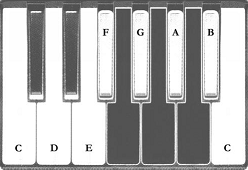 Alexandre Oberlin has a web page at
http://migo.info/music/bilinear_chromatic_keyboard.xhtml_en.php, where he
also describes the "Balanced" keyboard principles and layout, but instead
calling it by the name of the "Bilinear Uniform Chromatic Keyboard" (BUCK). In
particular, his web page contains more detail about musical intervals and key
spacings in relation to the Balanced / BUCK layout. Alexandre Oberlin has a web page at
http://migo.info/music/bilinear_chromatic_keyboard.xhtml_en.php, where he
also describes the "Balanced" keyboard principles and layout, but instead
calling it by the name of the "Bilinear Uniform Chromatic Keyboard" (BUCK). In
particular, his web page contains more detail about musical intervals and key
spacings in relation to the Balanced / BUCK layout.
|
Darin Gard - Alesis Q49 Balanced Keyboard Mod / YouTube video
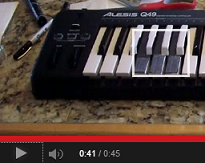 Darin Gard converted an
Alesis Q49 MIDI keyboard into the Balanced keyboard layout.
Darin explains: "I built a balanced keyboard from your designs and
instructions on your website from a 70 dollar Alesis Q49 49-key midi controller.
I wanted to help other people who are new to keyboards like me get
interested in using a cheap current midi controller that can have its keys removed.
I took a risk and bought the keyboard online and it was very easy
to remove and reorder the keys. Darin Gard converted an
Alesis Q49 MIDI keyboard into the Balanced keyboard layout.
Darin explains: "I built a balanced keyboard from your designs and
instructions on your website from a 70 dollar Alesis Q49 49-key midi controller.
I wanted to help other people who are new to keyboards like me get
interested in using a cheap current midi controller that can have its keys removed.
I took a risk and bought the keyboard online and it was very easy
to remove and reorder the keys.
"I used markers to color adhesive labels to recolor the
keys since I don't know whether the F based layout would be easier to play fingering-wise
than the C based layout, or what other differences there might be. I used the C based
layout for now... This balanced order is definitely easier for me to play and understand
chords compared to a regular keyboard."
|
"Usai" keyboard ("Tastiera Usai" in Italian) - Luigi Usai
In 2013
Luigi
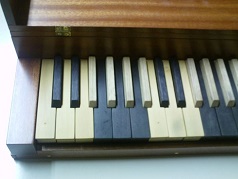 Usai had attempted to
develop a business called Usai Instruments based upon the Balanced keyboard layout, which he
had called the
"Usai" keyboard. Luigi's Facebook page for this project is at
https://www.facebook.com/nuovopiano. Usai had attempted to
develop a business called Usai Instruments based upon the Balanced keyboard layout, which he
had called the
"Usai" keyboard. Luigi's Facebook page for this project is at
https://www.facebook.com/nuovopiano.
Luigi had participated in the "Start Cup Veneto" business start-up competition in
Italy in the middle of 2013, in which his business came fourth.
Luigi posted a number of promotional videos on YouTube:
Video 1
Video 2
Video 3
Video 4
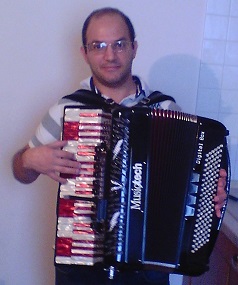
He also built an accordion with the layout:
|
|
|